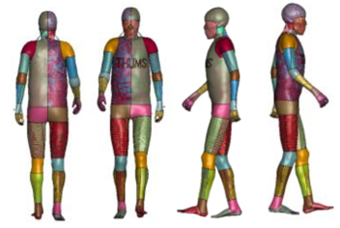Pedestrian safety has become a critical public concern in Vietnam’s rapidly growing urban centers, where mixed traffic environments expose vulnerable road users to a high risk of accidents. According to international data, lower limb injuries account for the majority of pedestrian traumas in vehicle collisions, particularly with sedan-type vehicles. In response to this issue, researchers from Van Lang University and Ho Chi Minh City University of Technology and Education conducted a finite element simulation study to analyze the mechanism of pedestrian lower extremity injuries using the V-THUMS model—a human body model scaled to Vietnamese anthropometry.
A localized approach using V-THUMS
Traditional human models like THUMS (Total Human Model for Safety) are based on Western body sizes and do not accurately represent the smaller body frames of Asian pedestrians. The research team addressed this limitation by developing V-THUMS (Vietnamese THUMS), which adjusts height, weight, and bone structure parameters to match the Vietnamese population. This adjustment ensures that simulations realistically reflect the biomechanical responses of Vietnamese pedestrians during impact.
![]()
 Figure 1: V-THUMS model
Figure 1: V-THUMS model
Using LS-DYNA software, the V-THUMS model was subjected to controlled collisions with three sedan vehicles — Ford Taurus, Dodge Neon, and Toyota Camry — traveling at 40 km/h. The simulations focused on the lower limb regions, including the femur, tibia, and knee joints, which are typically the first points of impact in pedestrian crashes.
Key results and injury analysis
The study revealed that:
- The Toyota Camry, having a higher bumper height (350 mm), generated greater bending moments and resultant forces, exceeding the European safety limit of 4 kN.
- The femur and tibia experienced critical stress levels, particularly in mid-shaft regions, indicating a high risk of fractures.
- Ligament strain in the knee joint showed deformation rates up to 28%, representing a high probability of ligament rupture.
- The Camry and Taurus models demonstrated distinct injury patterns due to differences in front-end geometry and stiffness.
These results demonstrate that vehicle design parameters — such as bumper height, profile curvature, and stiffness distribution — are decisive factors influencing pedestrian injury severity.
Implications for safety design
The study emphasizes that pedestrian protection measures must be localized, especially for developing countries like Vietnam where pedestrian characteristics differ from Western standards. The research provides essential insights for:
- Automotive manufacturers seeking to optimize vehicle front-end design for safer pedestrian interaction.
- Policymakers developing regulations tailored to regional body structures and traffic conditions.
- Engineers designing energy-absorbing materials and safety components to minimize impact forces.
Ultimately, the findings pave the way for human-centered vehicle design that aligns with Vietnam’s real-world mobility context and pedestrian safety priorities.